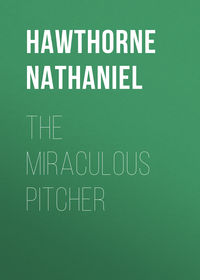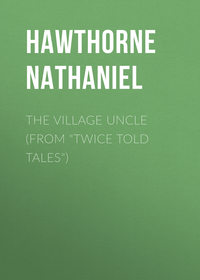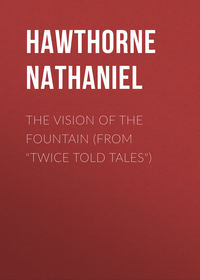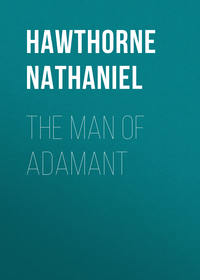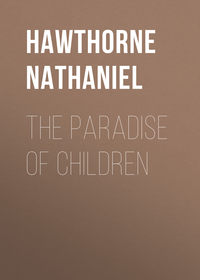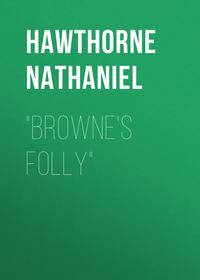 полная версия
полная версияPassages from the French and Italian Notebooks, Complete
Yesterday I went out betimes, and strayed through some portion of ancient Rome, to the Column of Trajan, to the Forum, thence along the Appian Way; after which I lost myself among the intricacies of the streets, and finally came out at the bridge of St. Angelo. The first observation which a stranger is led to make, in the neighborhood of Roman ruins, is that the inhabitants seem to be strangely addicted to the washing of clothes; for all the precincts of Trajan's Forum, and of the Roman Forum, and wherever else an iron railing affords opportunity to hang them, were whitened with sheets, and other linen and cotton, drying in the sun. It must be that washerwomen burrow among the old temples. The second observation is not quite so favorable to the cleanly character of the modern Romans; indeed, it is so very unfavorable, that I hardly know how to express it. But the fact is, that, through the Forum… and anywhere out of the commonest foot-track and roadway, you must look well to your steps… If you tread beneath the triumphal arch of Titus or Constantine, you had better look downward than upward, whatever be the merit of the sculptures aloft…
After a while the visitant finds himself getting accustomed to this horrible state of things; and the associations of moral sublimity and beauty seem to throw a veil over the physical meannesses to which I allude. Perhaps there is something in the mind of the people of these countries that enables them quite to dissever small ugliness from great sublimity and beauty. They spit upon the glorious pavement of St. Peter's, and wherever else they like; they place paltry-looking wooden confessionals beneath its sublime arches, and ornament them with cheap little colored prints of the crucifixion; they hang tin hearts and other tinsel and trumpery at the gorgeous shrines of the saints, in chapels that are incrusted with gems, or marbles almost as precious; they put pasteboard statues of saints beneath the dome of the Pantheon; in short, they let the sublime and the ridiculous come close together, and are not in the least troubled by the proximity. It must be that their sense of the beautiful is stronger than in the Anglo-Saxon mind, and that it observes only what is fit to gratify it.
To-day, which was bright and cool, my wife and I set forth immediately after breakfast, in search of the Baths of Diocletian, and the church of Santa Maria degl' Angeli. We went too far along the Via di Porta Pia, and after passing by two or three convents, and their high garden walls, and the villa Bonaparte on one side, and the villa Torlonia on the other, at last issued through the city gate. Before us, far away, were the Alban hills, the loftiest of which was absolutely silvered with snow and sunshine, and set in the bluest and brightest of skies. We now retraced our steps to the Fountain of the Termini, where is a ponderous heap of stone, representing Moses striking the rock; a colossal figure, not without a certain enormous might and dignity, though rather too evidently looking his awfullest. This statue was the death of its sculptor, whose heart was broken on account of the ridicule it excited. There are many more absurd aquatic devices in Rome, however, and few better.
We turned into the Piazza de' Termini, the entrance of which is at this fountain; and after some inquiry of the French soldiers, a numerous detachment of whom appear to be quartered in the vicinity, we found our way to the portal of Santa Maria degl' Angeli. The exterior of this church has no pretensions to beauty or majesty, or, indeed, to architectural merit of any kind, or to any architecture whatever; for it looks like a confused pile of ruined brickwork, with a facade resembling half the inner curve of a large oven. No one would imagine that there was a church under that enormous heap of ancient rubbish. But the door admits you into a circular vestibule, once an apartment of Diocletian's Baths, but now a portion of the nave of the church, and surrounded with monumental busts; and thence you pass into what was the central hall; now, with little change, except of detail and ornament, transformed into the body of the church. This space is so lofty, broad, and airy, that the soul forthwith swells out and magnifies itself, for the sake of filling it. It was Michael Angelo who contrived this miracle; and I feel even more grateful to him for rescuing such a noble interior from destruction, than if he had originally built it himself. In the ceiling above, you see the metal fixtures whereon the old Romans hung their lamps; and there are eight gigantic pillars of Egyptian granite, standing as they stood of yore. There is a grand simplicity about the church, more satisfactory than elaborate ornament; but the present pope has paved and adorned one of the large chapels of the transept in very beautiful style, and the pavement of the central part is likewise laid in rich marbles. In the choir there are several pictures, one of which was veiled, as celebrated pictures frequently are in churches. A person, who seemed to be at his devotions, withdrew the veil for us, and we saw a Martyrdom of St. Sebastian, by Domenichino, originally, I believe, painted in fresco in St. Peter's, but since transferred to canvas, and removed hither. Its place at St. Peter's is supplied by a mosaic copy. I was a good deal impressed by this picture, – the dying saint, amid the sorrow of those who loved him, and the fury of his enemies, looking upward, where a company of angels, and Jesus with them, are waiting to welcome him and crown him; and I felt what an influence pictures might have upon the devotional part of our nature. The nailmarks in the hands and feet of Jesus, ineffaceable, even after he had passed into bliss and glory, touched my heart with a sense of his love for us. I think this really a great picture. We walked round the church, looking at other paintings and frescos, but saw no others that greatly interested us. In the vestibule there are monuments to Carlo Maratti and Salvator Rosa, and there is a statue of St. Bruno, by Houdon, which is pronounced to be very fine. I thought it good, but scarcely worthy of vast admiration. Houdon was the sculptor of the first statue of Washington, and of the bust, whence, I suppose, all subsequent statues have been, and will be, mainly modelled.
After emerging from the church, I looked back with wonder at the stack of shapeless old brickwork that hid the splendid interior. I must go there again, and breathe freely in that noble space.
February 20th. – This morning, after breakfast, I walked across the city, making a pretty straight course to the Pantheon, and thence to the bridge of St. Angelo, and to St. Peter's. It had been my purpose to go to the Fontana Paolina; but, finding that the distance was too great, and being weighed down with a Roman lassitude, I concluded to go into St. Peter's. Here I looked at Michael Angelo's Pieta, a representation of the dead Christ, in his mother's lap. Then I strolled round the great church, and find that it continues to grow upon me both in magnitude and beauty, by comparison with the many interiors of sacred edifices which I have lately seen. At times, a single, casual, momentary glimpse of its magnificence gleams upon my soul, as it were, when I happen to glance at arch opening beyond arch, and I am surprised into admiration. I have experienced that a landscape and the sky unfold the deepest beauty in a similar way; not when they are gazed at of set purpose, but when the spectator looks suddenly through a vista, among a crowd of other thoughts. Passing near the confessional for foreigners to-day, I saw a Spaniard, who had just come out of the one devoted to his native tongue, taking leave of his confessor, with an affectionate reverence, which – as well as the benign dignity of the good father – it was good to behold…
I returned home early, in order to go with my wife to the Barberini Palace at two o'clock. We entered through the gateway, through the Via delle Quattro Fontane, passing one or two sentinels; for there is apparently a regiment of dragoons quartered on the ground-floor of the palace; and I stumbled upon a room containing their saddles, the other day, when seeking for Mr. Story's staircase. The entrance to the picture-gallery is by a door on the right hand, affording us a sight of a beautiful spiral staircase, which goes circling upward from the very basement to the very summit of the palace, with a perfectly easy ascent, yet confining its sweep within a moderate compass. We looked up through the interior of the spiral, as through a tube, from the bottom to the top. The pictures are contained in three contiguous rooms of the lower piano, and are few in number, comprising barely half a dozen which I should care to see again, though doubtless all have value in their way. One that attracted our attention was a picture of "Christ disputing with the Doctors," by Albert Duerer, in which was represented the ugliest, most evil-minded, stubborn, pragmatical, and contentious old Jew that ever lived under the law of Moses; and he and the child Jesus were arguing, not only with their tongues, but making hieroglyphics, as it were, by the motion of their hands and fingers. It is a very queer, as well as a very remarkable picture. But we passed hastily by this, and almost all others, being eager to see the two which chiefly make the collection famous, – Raphael's Fornarina, and Guido's portrait of Beatrice Cenci. These were found in the last of the three rooms, and as regards Beatrice Cenci, I might as well not try to say anything; for its spell is indefinable, and the painter has wrought it in a way more like magic than anything else…
It is the most profoundly wrought picture in the world; no artist did it, nor could do it, again. Guido may have held the brush, but he painted "better than he knew." I wish, however, it were possible for some spectator, of deep sensibility, to see the picture without knowing anything of its subject or history; for, no doubt, we bring all our knowledge of the Cenci tragedy to the interpretation of it.
Close beside Beatrice Cenci hangs the Fornarina…
While we were looking at these works Miss M – unexpectedly joined us, and we went, all three together, to the Rospigliosi Palace, in the Piazza di Monte Cavallo. A porter, in cocked hat, and with a staff of office, admitted us into a spacious court before the palace, and directed us to a garden on one side, raised as much as twenty feet above the level on which we stood. The gardener opened the gate for us, and we ascended a beautiful stone staircase, with a carved balustrade, bearing many marks of time and weather. Reaching the garden-level, we found it laid out in walks, bordered with box and ornamental shrubbery, amid which were lemon-trees, and one large old exotic from some distant clime. In the centre of the garden, surrounded by a stone balustrade, like that of the staircase, was a fish-pond, into which several jets of water were continually spouting; and on pedestals, that made part of the balusters, stood eight marble statues of Apollo, Cupid, nymphs, and other such sunny and beautiful people of classic mythology. There had been many more of these statues, but the rest had disappeared, and those which remained had suffered grievous damage, here to a nose, there to a hand or foot, and often a fracture of the body, very imperfectly mended. There was a pleasant sunshine in the garden, and a springlike, or rather a genial, autumnal atmosphere, though elsewhere it was a day of poisonous Roman chill.
At the end of the garden, which was of no great extent, was an edifice, bordering on the piazza, called the Casino, which, I presume, means a garden-house. The front is richly ornamented with bas-reliefs, and statues in niches; as if it were a place for pleasure and enjoyment, and therefore ought to be beautiful. As we approached it, the door swung open, and we went into a large room on the ground-floor, and, looking up to the ceiling, beheld Guido's Aurora. The picture is as fresh and brilliant as if he had painted it with the morning sunshine which it represents. It could not be more lustrous in its lines, if he had given it the last touch an hour ago. Three or four artists were copying it at that instant, and positively their colors did not look brighter, though a great deal newer than his. The alacrity and movement, briskness and morning stir and glow, of the picture are wonderful. It seems impossible to catch its glory in a copy. Several artists, as I said, were making the attempt, and we saw two other attempted copies leaning against the wall, but it was easy to detect failure in just essential points. My memory, I believe, will be somewhat enlivened by this picture hereafter: not that I remember it very distinctly even now; but bright things leave a sheen and glimmer in the mind, like Christian's tremulous glimpse of the Celestial City.
In two other rooms of the Casino we saw pictures by Domenichino, Rubens, and other famous painters, which I do not mean to speak of, because I cared really little or nothing about them. Returning into the garden, the sunny warmth of which was most grateful after the chill air and cold pavement of the Casino, we walked round the laguna, examining the statues, and looking down at some little fishes that swarmed at the stone margin of the pool. There were two infants of the Rospigliosi family: one, a young child playing with a maid and head-servant; another, the very chubbiest and rosiest boy in the world, sleeping on its nurse's bosom. The nurse was a comely woman enough, dressed in bright colors, which fitly set off the deep lines of her Italian face. An old painter very likely would have beautified and refined the pair into a Madonna, with the child Jesus; for an artist need not go far in Italy to find a picture ready composed and tinted, needing little more than to be literally copied.
Miss M – had gone away before us; but my wife and I, after leaving the Palazzo Rospigliosi, and on our way hone, went into the Church of St. Andrea, which belongs to a convent of Jesuits. I have long ago exhausted all my capacity of admiration for splendid interiors of churches, but methinks this little, little temple (it is not more than fifty or sixty feet across) has a more perfect and gem-like beauty than any other. Its shape is oval, with an oval dome, and, above that, another little dome, both of which are magnificently frescoed. Around the base of the larger dome is wreathed a flight of angels, and the smaller and upper one is encircled by a garland of cherubs, – cherub and angel all of pure white marble. The oval centre of the church is walled round with precious and lustrous marble of a red-veined variety interspersed with columns and pilasters of white; and there are arches opening through this rich wall, forming chapels, which the architect seems to have striven hard to make even more gorgeous than the main body of the church. They contain beautiful pictures, not dark and faded, but glowing, as if just from the painter's hands; and the shrines are adorned with whatever is most rare, and in one of them was the great carbuncle; at any rate, a bright, fiery gem as big as a turkey's egg. The pavement of the church was one star of various-colored marble, and in the centre was a mosaic, covering, I believe, the tomb of the founder. I have not seen, nor expect to see, anything else so entirely and satisfactorily finished as this small oval church; and I only wish I could pack it in a large box, and send it home.
I must not forget that, on our way from the Barberini Palace, we stopped an instant to look at the house, at the corner of the street of the four fountains, where Milton was a guest while in Rome. He seems quite a man of our own day, seen so nearly at the hither extremity of the vista through which we look back, from the epoch of railways to that of the oldest Egyptian obelisk. The house (it was then occupied by the Cardinal Barberini) looks as if it might have been built within the present century; for mediaeval houses in Rome do not assume the aspect of antiquity; perhaps because the Italian style of architecture, or something similar, is the one more generally in vogue in most cities.
February 21st. – This morning I took my way through the Porta del Popolo, intending to spend the forenoon in the Campagna; but, getting weary of the straight, uninteresting street that runs out of the gate, I turned aside from it, and soon found myself on the shores of the Tiber. It looked, as usual, like a saturated solution of yellow mud, and eddied hastily along between deep banks of clay, and over a clay bed, in which doubtless are hidden many a richer treasure than we now possess. The French once proposed to draw off the river, for the purpose of recovering all the sunken statues and relics; but the Romans made strenuous objection, on account of the increased virulence of malaria which would probably result. I saw a man on the immediate shore of the river, fifty feet or so beneath the bank on which I stood, sitting patiently, with an angling rod; and I waited to see what he might catch. Two other persons likewise sat down to watch him; but he caught nothing so long as I stayed, and at last seemed to give it up. The banks and vicinity of the river are very bare and uninviting, as I then saw them; no shade, no verdure, – a rough, neglected aspect, and a peculiar shabbiness about the few houses that were visible. Farther down the stream the dome of St. Peter's showed itself on the other side, seeming to stand on the outskirts of the city. I walked along the banks, with some expectation of finding a ferry, by which I might cross the river; but my course was soon interrupted by the wall, and I turned up a lane that led me straight back again to the Porta del Popolo. I stopped a moment, however, to see some young men pitching quoits, which they appeared to do with a good deal of skill.
I went along the Via di Ripetta, and through other streets, stepping into two or three churches, one of which was the Pantheon…
There are, I think, seven deep, pillared recesses around the circumference of it, each of which becomes a sufficiently capacious chapel; and alternately with these chapels there is a marble structure, like the architecture of a doorway, beneath which is the shrine of a saint; so that the whole circle of the Pantheon is filled up with the seven chapels and seven shrines. A number of persons were sitting or kneeling around; others came in while I was there, dipping their fingers in the holy water, and bending the knee, as they passed the shrines and chapels, until they reached the one which, apparently, they had selected as the particular altar for their devotions. Everybody seemed so devout, and in a frame of mind so suited to the day and place, that it really made me feel a little awkward not to be able to kneel down along with them. Unlike the worshippers in our own churches, each individual here seems to do his own individual acts of devotion, and I cannot but think it better so than to make an effort for united prayer as we do. It is my opinion that a great deal of devout and reverential feeling is kept alive in people's hearts by the Catholic mode of worship.
Soon leaving the Pantheon, a few minutes' walk towards the Corso brought me to the Church of St. Ignazio, which belongs to the College of the Jesuits. It is spacious and of beautiful architecture, but not strikingly distinguished, in the latter particular, from many others; a wide and lofty nave, supported upon marble columns, between which arches open into the side aisles, and at the junction of the nave and transept a dome, resting on four great arches. The church seemed to be purposely somewhat darkened, so that I could not well see the details of the ornamentation, except the frescos on the ceiling of the nave, which were very brilliant, and done in so effectual a style, that I really could not satisfy myself that some of the figures did not actually protrude from the ceiling, – in short, that they were not colored bas-reliefs, instead of frescos. No words can express the beautiful effect, in an upholstery point of view, of this kind of decoration. Here, as at the Pantheon, there were many persons sitting silent, kneeling, or passing from shrine to shrine.
I reached home at about twelve, and, at one, set out again, with my wife, towards St. Peter's, where we meant to stay till after vespers. We walked across the city, and through the Piazza de Navona, where we stopped to look at one of Bernini's absurd fountains, of which the water makes but the smallest part, – a little squirt or two amid a prodigious fuss of gods and monsters. Thence we passed by the poor, battered-down torso of Pasquin, and came, by devious ways, to the bridge of St. Angelo; the streets bearing pretty much their weekday aspect, many of the shops open, the market-stalls doing their usual business, and the people brisk and gay, though not indecorously so. I suppose there was hardly a man or woman who had not heard mass, confessed, and said their prayers; a thing which – the prayers, I mean – it would be absurd to predicate of London, New York, or any Protestant city. In however adulterated a guise, the Catholics do get a draught of devotion to slake the thirst of their souls, and methinks it must needs do them good, even if not quite so pure as if it came from better cisterns, or from the original fountain-head.
Arriving at St. Peter's shortly after two, we walked round the whole church, looking at all the pictures and most of the monuments… and paused longest before Guido's "Archangel Michael overcoming Lucifer." This is surely one of the most beautiful things in the world, one of the human conceptions that are imbued most deeply with the celestial…
We then sat down in one of the aisles and awaited the beginning of vespers, which we supposed would take place at half past three. Four o'clock came, however, and no vespers; and as our dinner-hour is five… we at last cane away without hearing the vesper hymn.
February 23d. – Yesterday, at noon, we set out for the Capitol, and after going up the acclivity (not from the Forum, but from the opposite direction), stopped to look at the statues of Castor and Pollux, which, with other sculptures, look down the ascent. Castor and his brother seem to me to have heads disproportionately large, and are not so striking, in any respect, as such great images ought to be. But we heartily admired the equestrian statue of Marcus Aurelius Antoninus… and looked at a fountain, principally composed, I think, of figures representing the Nile and the Tiber, who loll upon their elbows and preside over the gushing water; and between them, against the facade of the Senator's Palace, there is a statue of Minerva, with a petticoat of red porphyry. Having taken note of these objects, we went to the museum, in an edifice on our left, entering the piazza, and here, in the vestibule, we found various old statues and relics. Ascending the stairs, we passed through a long gallery, and, turning to our left, examined somewhat more carefully a suite of rooms running parallel with it. The first of these contained busts of the Caesars and their kindred, from the epoch of the mightiest Julius downward; eighty-three, I believe, in all. I had seen a bust of Julius Caesar in the British Museum, and was surprised at its thin and withered aspect; but this head is of a very ugly old man indeed, – wrinkled, puckered, shrunken, lacking breadth and substance; careworn, grim, as if he had fought hard with life, and had suffered in the conflict; a man of schemes, and of eager effort to bring his schemes to pass. His profile is by no means good, advancing from the top of his forehead to the tip of his nose, and retreating, at about the same angle, from the latter point to the bottom of his chin, which seems to be thrust forcibly down into his meagre neck, – not that he pokes his head forward, however, for it is particularly erect.
The head of Augustus is very beautiful, and appears to be that of a meditative, philosophic man, saddened with the sense that it is not very much worth while to be at the summit of human greatness after all. It is a sorrowful thing to trace the decay of civilization through this series of busts, and to observe how the artistic skill, so requisite at first, went on declining through the dreary dynasty of the Caesars, till at length the master of the world could not get his head carved in better style than the figure-head of a ship.
In the next room there were better statues than we had yet seen; but in the last room of the range we found the "Dying Gladiator," of which I had already caught a glimpse in passing by the open door. It had made all the other treasures of the gallery tedious in my eagerness to come to that. I do not believe that so much pathos is wrought into any other block of stone. Like all works of the highest excellence, however, it makes great demands upon the spectator. He must make a generous gift of his sympathies to the sculptor, and help out his skill with all his heart, or else he will see little more than a skilfully wrought surface. It suggests far more than it shows. I looked long at this statue, and little at anything else, though, among other famous works, a statue of Antinous was in the same room.


